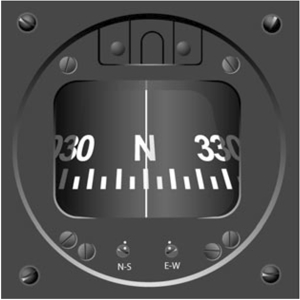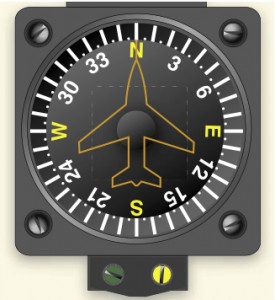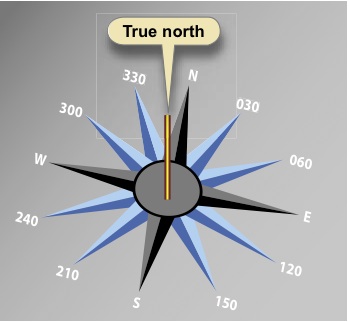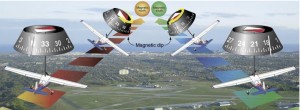 A reader asks "I know the airplane must have a magnetic compass but I heard the compass error cannot be more than ten degrees”. My friend flies a plane with more than a ten degree error. Is this legal? Also how is the compass tested and how often is it checked?
A reader asks "I know the airplane must have a magnetic compass but I heard the compass error cannot be more than ten degrees”. My friend flies a plane with more than a ten degree error. Is this legal? Also how is the compass tested and how often is it checked?
Requirements
The compass is an instrument which often is ignored in modern technically advanced aircraft, but it is one of the most important instruments in our airplane. A magnetic direction indicator is required in all aircraft with a standard airworthiness certificate, see Title 14 Code of Federal Regulations Part 91.205 Besides being required by law, how else would we be able to determine our direction if all of that advanced equipment fails in flight.
Deviation
 All magnets are prone to errors due to magnetic flux generated when the electrical equipment in the airplane is turned on. This error is called deviation error. Many of us fly airplanes with a vertical compass card which is less prone to oscillations in flight but is still prone to the same magnetic errors.
All magnets are prone to errors due to magnetic flux generated when the electrical equipment in the airplane is turned on. This error is called deviation error. Many of us fly airplanes with a vertical compass card which is less prone to oscillations in flight but is still prone to the same magnetic errors.
Compass Correction Card and Swinging The Compass
 To compensate for the magnetic errors produced by the electrical equipment in the aircraft a compass correction card is installed in the aircraft. The compass correction card shows every 30 degrees of heading and a box underneath with a value filled in by the mechanic when they "swung the compass".
To compensate for the magnetic errors produced by the electrical equipment in the aircraft a compass correction card is installed in the aircraft. The compass correction card shows every 30 degrees of heading and a box underneath with a value filled in by the mechanic when they "swung the compass".
Most airports have a compass rose with cardinal headings painted on the surface. The Aviation Maintenance Technician, AMT, will carefully taxi the airplane onto the compass rose and align the airplane with each of the cardinal headings. The AMT will note the heading on the magnetic compass indication and if there is an error try to adjust the compensating magnets to remove any errors

More than ten degrees of error
Any errors the AMT cannot remove must be noted on the compass correction card which is placed on or near the magnetic compass. It is a common misunderstanding that a compass cannot have more than ten degrees of error because the regulations in part 23.1327 state the "compensated instillation must not have more than ten degrees of error in level flight".
If you continue to read the regulation the last sentence allows for "deviations of a magnetic non stabilized direction indicator of more than 10 degrees" but the deviations must be placarded and in compliance with part 23.1547(e). The regulation says the placard must state which electrical loads, or combination of loads, would cause a deviation of more than 10 degrees when turned on.
When Must We Swing The Compass?
Advisory Circular AC 43.13-1B contains practices and repair methods. The Advisory Circular states the AMT must swing the compass for the following reasons:
(1) When the accuracy of the compass is suspected.
(2) After any cockpit modification or major replacement involving ferrous metal.
(3) Whenever a compass has been subjected to a shock; for example, after a hard landing or turbulence.
(4) After aircraft has passed through a severe electrical storm.
(5) After lighting strike.
(6) Whenever a change is made to the electrical system.
(7) Whenever a change of cargo is likely to affect the compass.
(8) When an aircraft operation is changed to a different geographic location with a major change in magnetic deviation. (e.g., from Miami, Florida to Fairbanks, Alaska.)
(9) After aircraft has been parked on one heading for over a year.
(10) When flux valves are replaced.
The only problem I have with this advisory circular is their example of a compass being subjected to a "shock". Their example of a "hard landing" is subjective. Just make sure an airworthiness inspector is not within ear shot when you comment "boy that was a hard landing". You might be required to swing the compass afterwards. Seriously though if it has been a bouncy day, either weather or pilot induced, and you notice your compass is not reading accurately you should talk to a mechanic because it might be time to swing the compass.
Conclusion
The magnetic compass is often overlooked because the electronics in our new technically advanced aircraft will give us a more accurate heading indication without much thought process. A magnetic compass, especially the old “whiskey” compass requires some knowledge and training in proper usage. When was the last time you did compass turns? Maybe it is time to practice and become proficient using the magnetic compass again.

During your review of the compass you might find on one heading there is more than a ten degree heading error which might be cause for alarm. You may remember hearing from your instructor “There can be no more than a ten degree error so you can’t fly.” As you now understand this is not the case as long as the error over ten degrees has been noted and placarded.
The placard must indicate the specific electronic equipment operating when the error was noted. Normally the placard will include two lines, one with the compass error with all the radio equipment on and one without the radios on. This will assist you in steering when you have a complete electrical failure and have turned all of your radios off.
Multiple electronic heading indicating systems result in our rarely using the magnetic compass except for aligning the heading indicator during preflight and readjustment during cross country flights. If you have an electronic heading and attitude referencing system you may only check your heading displayed on the electronic display before flight and ignore the compass the remainder of the flight.
Although rare, all of your electronic systems can fail and the only remaining heading instrument is your magnetic compass. It happened to my coworker recently. To stay proficient take notice of the movement of the magnetic compass during turns and accelerated flight. Try to anticipate what the compass will do while you maneuver the aircraft. If you have any questions regarding the use of the compass find a flight instructor and have them show you its proper use. This will make you a safer and more proficient pilot especially when your electronic or gyroscopically stabilized heading indicator fails.
Safe Flying!

Comments on this entry are closed.
Samsung has released two new cell phones in its Galaxy line, and
it’s really interesting to compare the two.